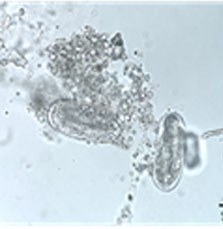ประสิทธิภาพการทำงานร่วมกันของรา Trichoderma asperellum สายพันธุ์ Cb-pin01 และแบคทีเรีย Streptomyces sp. สายพันธุ์ KPS-E004 ในการควบคุมไส้เดือนฝอยรากปม Meloidogyne enterolobii ในพริก
คำสำคัญ:
โรครากปมพริก, การควบคุมโดยชีววิธี ไตรโคเดอร์มา สเตรปโตมัยซีทบทคัดย่อ
Meloidogyne enterolobii เป็นสาเหตุหนึ่งที่ทำให้พริก (Capsicum frutescens L.) สูญเสียผลผลิตอย่างมีนัยสำคัญ งานวิจัยนี้ได้ศึกษาประสิทธิภาพของการทำงานร่วมกันของเชื้อรา T. asperellum สายพันธุ์ Cb-pin01 และ Streptomyces sp. สายพันธุ์ KPS-E004 ต่อการเจริญเติบโตและการควบคุมไส้เดือนฝอยรากปม M. enterolobii ในพริก จากผลการทดสอบภายในห้องปฏิบัติการพบว่าการปลูกเชื้อทั้งสองสายพันธุ์ร่วมกัน มีผลในการลดอัตราการฟักของไข่ เพิ่มอัตราการตาย และยับยั้งการเข้าสู่รากพืชของตัวอ่อนระยะที่ 2 ของไส้เดือนฝอยรากปม M. enterolobii สูงถึง 75.33%, 62.44% และ 98.67% ตามลำดับ เมื่อเปรียบเทียบกับชุดควบคุม และเมื่อทดสอบกับพริกในสภาพโรงเรือน พบว่าการปลูกเชื้อทั้งสองสายพันธุ์ร่วมกัน มีผลในการลดจำนวนกลุ่มไข่ ลดจำนวนตัวอ่อนในดิน และมีประสิทธิภาพในการลดการเกิดปมของรากพริกได้สูงถึง 71.05%, 75.68% และ 50% ตามลำดับ เมื่อเปรียบเทียบกับชุดควบคุมที่มีการปลูกไส้เดือนฝอยเพียงอย่างเดียว อีกทั้งเพิ่มประสิทธิภาพในการลดการเกิดปมของรากพริกได้สูงถึง 150.02% เมื่อเปรียบเทียบกับการใช้สายพันธุ์ Cb-pin01 เพียงชนิดเดียว นอกจากนี้การใส่เชื้อแบบผสมสามารถส่งเสริมการเจริญเติบโตของพริก โดยเพิ่มน้ำหนักและความสูงของลำต้น ความยาวราก และเพิ่มน้ำหนักผลผลิตได้ถึง 129.65%, 139.63%, 122.89% และ 165.51% ตามลำดับ (เมื่อเปรียบเทียบกับชุดควบคุมต้นปกติ) จากผลการทดลองนี้ชี้ให้เห็นว่าการปลูกเชื้อผสมร่วมกันระหว่าง T. asperellum สายพันธุ์ Cb-pin01 และ Streptomyces sp. สายพันธุ์ KPS-E004 สามารถเพิ่มศักยภาพในการควบคุมโรครากปมพริกในระดับแปลงปลูก
เอกสารอ้างอิง
กรมวิชาการเกษตร. 2562. สถานการณ์การผลิตพริก. แหล่งที่มา: https://www.doa.go.th/hort/wp- content/uploads/2020/10.pdf,24 กรกฎาคม 2565.
จิระเดช แจ่มสว่าง และวรรณวิไล อินทนู. 2545. การผลิตเชื้อราไตรโคเดอร์มาชนิดสดด้วยเทคนิคอย่างง่ายเพื่อใช้
ควบคุมโรครากเน่าระดับดินของถั่วฝักยาวที่เกิดจากเชื้อรา Sclerotium rolfsii. ใน: การประชุมวิชาการของมหาวิทยาลัยเกษตรศาสตร์ ครั้งที่ 40. 4-7 กุมภาพันธ์ 2545. กรุงเทพฯ.
ชนากานต์ บุญรินทร์, บัญชา ชิณศรี, อนงค์นุช สาสนรักกิจ และศรีเมฆ ชาวโพงพาง. 2562. จัดจําแนกไส้เดือน
ฝอยรากปม (Meloidogyne enterolobii) ในแปลงปลูกพริกที่จังหวัดอุบลราชธานี, น. 713-722. ใน: การประชุมวิชาการเสนอผลงานวิจัยระดับบัณฑิตศึกษาแห่งชาติ ครั้งที่ 20. 15 มีนาคม 2562. มหาวิทยาลัยขอนแก่น, ขอนแก่น.
Affokpon, A., D. L. Coyne, C. C. Htay, R. D. Agbèdè, L. Lawouin and J. Coosemans. 2011. Biocontrol potential of native Trichoderma isolates against root-knot nematodes in West African vegetable production systems. Soil Biology and Biochemistry 43(3): 600-608.
Barker, K.R.1985. Nematode extraction and bioassays, pp.29-30. In: K.R. Barker, C.C. Carter and J.N. Sasser (Eds.). An Advanced Treatise on Meloidogyne, vol II., North Carolina State University
Graphics, Raleigh, North Carolina.
Byrd, D.W. Jr., T. Kirkpatrick and K.R. Barker. 1983. An improved technique for clearing and
staining plant tissue for detection of nematodes. Journal of Nematology 15:142-143.
Chamswarng, C., W. Intana and P. Yenjit. 2014. Efficacy of Trichoderma harzianum, Bacillus cereus and their lytic enzymes for the control of damping-off disease of yard long bean caused
by Pythium aphanidermatum. The Philippine Agricultural Scientist 96: 377-383.
Hunt, D. J. and Z. A. Handoo. 2009. Taxonomy, identification and principal species. pp. 55-97. In:
Root-knot Nematodes. CAB International. Wallingford.
Hashem, M. and K. A. Abo-Elyousr. 2011. Management of the root-knot nematode Meloidogyne
incognita on tomato with combinations of different biocontrol organisms. Crop Protection 30(3): 285-292.
Jindapunnapat, K. 2012. Development of the Molecular Markers for Species Identification of Root-knot Nematode Infesting Guava in Thailand. M.S. Thesis, Kasetsart University.84 P.
Jindapunnapat, K., B. Chinnasri and S. Kwankuae. 2013. Biological control of root-knot nematodes (Meloiodogyne enterolobii) in guava by the fungus Trichoderma harzianum. Journal of Developments in Sustainable Agriculture 8: 110-118.
Ruanpanun, P. and C. Chamswarng. 2016. Potential of actinomycetes isolated from earthworm
castings in controlling root-knot nematode Meloidogyne incognita. Journal of General Plant Pathology 82(1): 43-50.
Ruanpanun, P., N. Tangchitsomkid, K. D. Hyde and S. Lumyong. 2010. Actinomycetes and fungi
isolated from plant-parasitic nematode infested soils: screening of the effective biocontrol potential, indole-3-acetic acid and siderophore production. World Journal of Microbiology and Biotechnology 26(9): 1569-1578.
Sahebani, N. and N. Hadavi. 2008. Biological control of the root-knot nematode Meloidogyne javanica by Trichoderma harzianum. Soil Biology and Biochemistry 40(8): 2016-2020.
Sun, M. H., L. Gao, Y. X. Shi, B. J. Li and X. Z. Liu. 2006. Fungi and actinomycetes associated with
Meloidogyne spp. eggs and females in China and their biocontrol potential. Journal of
Invertebrate Pathology 93(1): 22-28.
Tigano, M., K. De Siqueira, P. Castagnone-Sereno, K. Mulet, P. Queiroz, M. Dos Santos, C.
Teixeira, M. Almeida, J. Silva and R. Carneiro. 2010. Genetic diversity of the root-knot
nematode Meloidogyne enterolobii and development of a SCAR marker for the guava-
damaging species. Plant Pathology 59:1054–1061.






